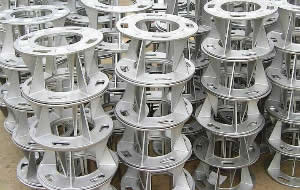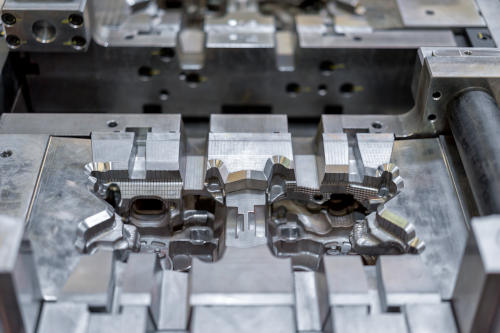The expertise that defines a professional Aluminum Casting Company
Wiki Article
Comprehensive Overview to the Uses and Production Techniques in Light Weight Aluminum Foundry Operations
The comprehensive overview to aluminum shop procedures provides crucial insights into the diverse applications of aluminum across numerous industries. It methodically takes a look at vital manufacturing strategies, melting processes, and molding approaches that add to precision and top quality. Furthermore, the overview highlights the value of finishing processes that enhance both mechanical residential or commercial properties and look. Understanding these components is crucial for any person associated with light weight aluminum manufacturing, questioning concerning ideal techniques and developments in the area.Overview of Light Weight Aluminum Casting Applications

In addition, the construction market take advantage of aluminum spreadings in building components and architectural elements, using longevity and resistance to deterioration. Customer products, such as cookware and home appliances, also use aluminum castings for their heat conductivity and visual charm. The electronic devices field relies upon aluminum for real estates and warm sinks, ensuring reliable thermal management. In general, aluminum spreading's adaptability permits it to meet varied market needs successfully, solidifying its relevance in modern production techniques.
Trick Production Techniques in Aluminum Foundry
In the domain name of light weight aluminum factory operations, various production methods play an essential function fit the last items that offer varied markets. Aluminum Casting. Secret techniques consist of sand spreading, pass away spreading, and financial investment spreading, each offering distinctive advantages based upon the application demandsSand spreading makes use of a mixture of sand and binder to produce molds, enabling for complicated geometries at lower expenses. Pass away casting, on the various other hand, utilizes high-pressure injection of molten aluminum right into steel mold and mildews, making certain accuracy and a smooth surface area coating, ideal for high-volume manufacturing. Financial investment casting offers exceptional dimensional precision and surface high quality, making it appropriate for intricate layouts.
Furthermore, methods such as permanent mold and mildew spreading and gravity die casting additionally enhance the adaptability of aluminum factory operations (Aluminum Casting). Each approach is chosen based upon factors like production quantity, part intricacy, and material residential properties, making certain positive results throughout different applications
Melting Procedures and Temperature Control
Reliable melting procedures and specific temperature control are essential for accomplishing excellent light weight aluminum foundry operations. The melting of aluminum generally entails various approaches, consisting of crucible melting, induction melting, and rotary melting, each with its very own benefits and applications. Crucible melting is generally used for small batches, while induction melting gives efficient home heating and uniform temperature circulation.
Molding Strategies for Accuracy Castings
Mastering molding methods is crucial for creating precision spreadings in light weight aluminum factory procedures. Different techniques, such as sand, investment, and die casting, play an essential function in achieving desired resistances and surface area coatings. Sand spreading, for instance, uses a blend of sand and binder to develop mold and mildews, permitting intricate layouts and large parts. Investment spreading, on the other hand, uses wax patterns that are covered in ceramic product, leading to extremely outlined and specific forms. Pass away casting utilizes high-pressure shot of liquified aluminum right into metal molds, guaranteeing constant dimensions and rapid production rates.Each strategy has its advantages and is chosen based upon factors such as complexity, volume, and mechanical homes needed. Efficient mold design, consisting of airing vent and gating systems, additionally boosts the top quality and precision of the completed product. Recognizing these molding strategies enables foundries to satisfy specific market needs and enhance general functional effectiveness.
Finishing Processes to Enhance Aluminum Elements
Finishing procedures play a critical function in enhancing the performance and visual appeals of light weight aluminum components. These processes, which follow spreading, aim to enhance surface high quality, corrosion resistance, and mechanical residential properties. Usual methods consist of machining, which fine-tunes dimensions and surface finish, and sprucing up, which improves visual appeal by creating a smooth, reflective surface area.Anodizing is an additional substantial procedure, giving a sturdy oxide layer that shields against wear and corrosion while enabling for color customization. Furthermore, powder finish offers a vast array of shades and surfaces, guaranteeing both defense and visual improvement.
In some cases, components may go through shot blasting to boost and remove pollutants adhesion for succeeding finishings (aluminum casting company). Generally, these finishing processes are crucial for taking full advantage of the functionality and life-span of light weight aluminum parts, making them appropriate for diverse applications throughout different markets
Regularly Asked Concerns
What Precaution Are Required in Light Weight Aluminum Shop Workflow?
In light weight aluminum foundry procedures, essential safety steps consist of personal safety tools, appropriate air flow, fire avoidance protocols, regular tools maintenance, training for workers on threats, and maintaining clear emergency treatments to ensure a secure workplace.Just How Do Ecological Rules Impact Aluminum Foundries?
Ecological regulations substantially affect light weight aluminum shops by imposing standards for discharges, waste administration, and resource intake. Compliance commonly demands investments in cleaner innovations and procedures, eventually affecting functional expenses and production efficiency within the industry.What Occupation Opportunities Exist in Aluminum Shop Workflow?
Different job possibilities in light weight aluminum factory operations include functions such as shop specialist, mold and mildew developer, quality assurance inspector, procedure designer, and manufacturing supervisor, each contributing to reliable manufacturing and ingenious processes within the market.Exactly How Is Top Quality Control Achieved in Aluminum Casting?
Quality assurance in aluminum casting is accomplished through rigorous assessments, standard screening treatments, and making use of innovative innovations. Normal monitoring of temperature, structure, and dimensional precision assurances products meet defined standards and customer needs.What Are the Usual Problems in Aluminum Castings and Their Causes?
Common issues in aluminum castings include porosity, shrinking, and surface area roughness. Causes commonly stem from improper mold design, poor pouring methods, and contamination, influencing the general stability and efficiency of the end product.The substantial overview to light weight aluminum foundry procedures offers vital understandings right into the varied applications of light weight aluminum throughout various industries. Aluminum spreading plays a necessary function in various markets due to its convenience and beneficial residential or commercial properties. Pass away casting, on the other hand, employs high-pressure shot of molten aluminum into steel mold and mildews, making aluminum foundry sure precision and a smooth surface coating, ideal for high-volume production. Additionally, techniques such as irreversible mold casting and gravity pass away casting further improve the flexibility of aluminum shop procedures. Grasping molding techniques is essential for generating accuracy castings in light weight aluminum shop operations.
Report this wiki page